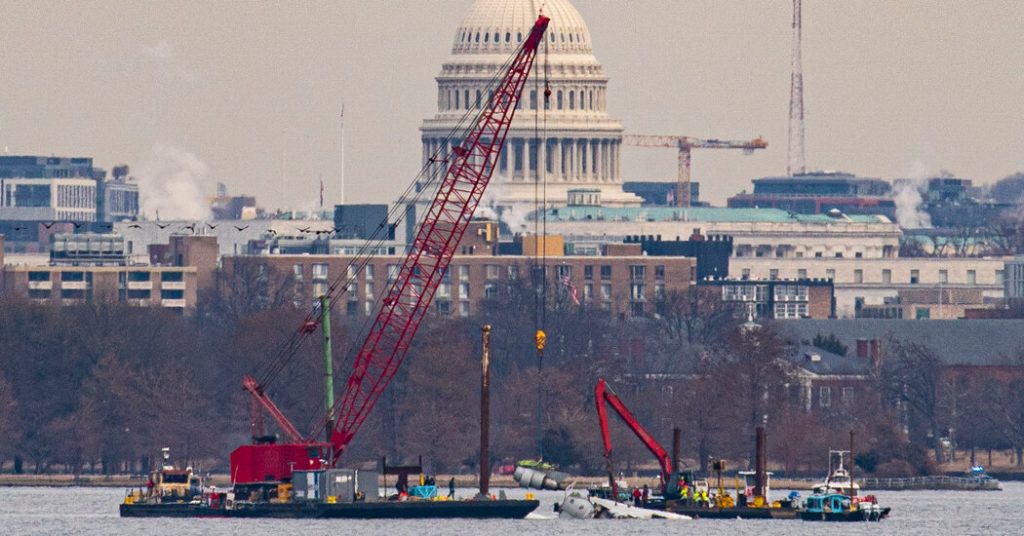It was a somber Monday morning in Washington as salvage crews began the challenging task of lifting the wreckage of American Airlines Flight 5342 from the depths of the Potomac River. The air was heavy with the weight of last week’s tragedy—a fatal midair collision between the passenger jet and an Army helicopter that left no survivors and raised urgent questions about aviation safety. By 10 a.m. Eastern Time, the first piece of debris emerged from the river: one of the plane’s engines, hoisted out by a crane stationed on a barge. It was a haunting reminder of the catastrophic events that unfolded just days earlier.
The operation, expected to span three days, began in earnest with boats and crews assembling on the cold, murky waters around 8 a.m. Col. Francis Pera of the Army Corps of Engineers had cautioned the public on Sunday about the delicate and grim nature of the task. Salvage efforts would undoubtedly uncover more victims’ bodies, as officials worked meticulously to recover the remains of those aboard the two doomed aircraft.
The collision, which occurred on a clear Wednesday night, marked the deadliest U.S. air crash in two decades and left both the aviation and military communities reeling. Aboard Flight 5342 were 64 passengers and crew, alongside three Army personnel in the helicopter. None survived the crash. By Sunday afternoon, officials had confirmed the recovery of 55 victims’ remains, but the river still held more unaccounted souls. Recovery teams, clad in winter gear to combat the frigid temperatures, continued their exhaustive search in hopes of returning all victims to their grieving families.
Once the wreckage is fully retrieved, Flight 5342 will be transported by flatbed trailer to a hangar for further analysis. Investigators are tasked with piecing together the events that led to this unprecedented disaster. Right now, answers are few, and speculation is premature, but the incident has already ignited discussions about safety protocols, congestion, and staffing at the increasingly overburdened Ronald Reagan National Airport.
The crash unfolded around 9 p.m., as Flight 5342 approached its final destination under the cover of a starry, clear sky. How two experienced pilots, each commanding sophisticated machines, could collide so tragically near one of the nation’s busiest airports remains unclear. The disaster serves as a chilling reminder of the complexity and fragility of modern air travel, where even the slightest miscalculation or miscommunication can have catastrophic consequences.
The scene on the Potomac is stark and sorrowful: recovery boats crisscrossing the river as divers work against poor visibility and freezing water temperatures to retrieve wreckage and any remaining victims. Amid the tragedy, there’s a drive for answers, with investigators from various federal agencies painstakingly examining every clue. The coming days will not only be about piecing together parts of the aircraft but also unraveling the mystery of how such a calamity occurred.
What we know so far is that the collision occurred in restricted airspace—an area often congested with both civilian and military traffic. Ronald Reagan National Airport, already infamous for tight flight paths and high traffic levels, now finds itself under intense scrutiny. The crash has reignited debates over whether increased safeguards are needed to prevent more such accidents, especially as air traffic continues to increase.
In the midst of this unfolding narrative, we are reminded of the devastating human toll. The names and faces of the 67 victims—spanning from passengers who were just trying to get home to military personnel serving their country—are not forgotten. For their families and loved ones, the wreckage being pulled from the river isn’t just debris; it’s a physical connection to a life lost too soon.
For now, the Potomac holds both the answers investigators seek and the remains of those whose lives were tragically cut short. In the coming days and weeks, the puzzle pieces of this catastrophe will slowly start coming together. What caused a passenger plane and a military helicopter to collide so abruptly in seemingly manageable conditions? Were there failures in protocol, deficiencies in communication, or just an incredibly rare and unfortunate chain of events that led to this bleak moment?
As the salvage operations continue and investigators turn over every piece of evidence, the local community and the nation at large watch closely, yearning for clarity and resolution. For now, though, the waters of the Potomac seem to echo the grief and uncertainty that hang in the air—a silent, somber witness to one of the darkest nights in modern aviation history.


